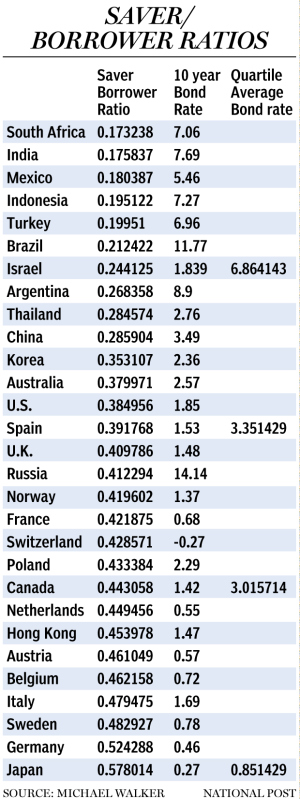Interest rates are low because of demographics; an aging population of savers creates a borrower's market
The Bank of Canada apparently surprised the chattering classes and everybody else this week by dropping its benchmark interest rate. The element of surprise, of course, reflected the firmly held convictions by Bank economists, and it would appear many others, that interest rates are now abnormally low and will soon return to more normal levels. In truth, it is the continuing hope/prediction/wish that interest rates would, will or should go higher that is surprising.
The false hopes and predictions of economists arise from the application to current circumstances of a model about economic behaviour that was built for a period of history that had a very different structure. All of the models and most of the theory behind them were built for an epoch of history - the first two-thirds of the 20th century - in which brisk population growth was a constant. While some model architects knew that constant population growth was necessary for the models to work, none of the current users seem to grasp it.
Why does population growth and its fluctuations matter for interest rates? Because it determines the relative number of (net) savers and borrowers in the population of a country. Young people are generally borrowers. Middle-aged and old people are generally savers. The relative number of savers and borrowers and the size of their need for one or the other have a determinative impact on the market for loanable funds.
In a steadily growing population, the largest cohort of people is the most recently born and therefore borrowers predominate and interest rates have to be high enough to temper demands of borrowers and encourage savers to do more. Constantly growing populations create a "savers market" where savers can select from a sea of qualified borrowers. If the population growth falters, stalls or declines the balance of saving and borrowing activity changes and the role of interest rates has also to change.
In the case where population growth falls and then ceases, like say Japan or Germany, or most of the EU, the largest population cohorts will be those that have been associated with the years of greatest population growth. As those largest cohorts age, they become the net savers in the country. The fact that the cohorts behind them - the younger borrowing-prone groups - are relatively smaller than in the past means that there are fewer opportunities for savers to deploy their savings. The loanable funds market becomes a "borrowers market." In such a market, interest rates fall to encourage more borrowing and to discourage saving.
In a soon to be published paper, I have explored the application of this model to the 29 countries that produce 90 per cent of the world's GDP. I have created a Saver/Borrower ratio, which is the total fraction of the population between the age of 50 and 74 divided by the fraction of the population aged 0-49. Low values of the ratio indicate the country has a "Savers Market" while higher values indicate a "Borrowers Market." In the table nearby the ratio is displayed for the 29 countries that producer 90 per cent of the world’s output.
The ratio is lowest for South Africa and highest for Japan. The higher numbers catalogue the aging European populations and highlight important differences between Canada and the United States and Australia with whom we often compare ourselves. The youthful rapidly growing countries are in the lower end of the ratio's range.
The third column in the table shows Jan 22, 2015, 10-year bond yields for the countries and the final column shows the quartile average rate of interest. Generally, the closer a country gets to a Japanese-type Saver/Borrower ratio, the lower the interest rate. There are anomalies, Brazil, Argentina and Russia being the most obvious, but the pattern is totally consistent with the notion that it is the relative prevalence of savers that has determined the persistently low interest rates we have been experiencing. In fact, the outliers mentioned aside, the variations in the Saver/Borrower ratio explains 80 per cent of the variation in the interest rates of the relevant economic world.
It's time to abandon the notion that world interest rates are going back up to historic levels - at least in countries that have migrated into the Borrower's market end of the demographic spectrum. The Bank of Canada, to which I gave a copy of an earlier version of my paper when it was under Mark Carney's governance, seems to have done just that. And appropriately so, because the interest rates reflecting these inexorable demographic forces are something like the natural rate of interest, and even low rates of interest which are maintained by central banks above those levels will have a depressing effect on economies already slowing for other reasons.

Author:
Subscribe to the Fraser Institute
Get the latest news from the Fraser Institute on the latest research studies, news and events.

